Related Research Articles

Smoke is a suspension of airborne particulates and gases emitted when a material undergoes combustion or pyrolysis, together with the quantity of air that is entrained or otherwise mixed into the mass. It is commonly an unwanted by-product of fires, but may also be used for pest control (fumigation), communication, defensive and offensive capabilities in the military, cooking, or smoking. It is used in rituals where incense, sage, or resin is burned to produce a smell for spiritual or magical purposes. It can also be a flavoring agent and preservative.
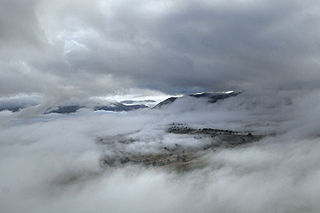
An aerosol is a suspension of fine solid particles or liquid droplets in air or another gas. Aerosols can be generated from natural or human causes. The term aerosol commonly refers to the mixture of particulates in air, and not to the particulate matter alone. Examples of natural aerosols are fog, mist or dust. Examples of human caused aerosols include particulate air pollutants, mist from the discharge at hydroelectric dams, irrigation mist, perfume from atomizers, smoke, dust, sprayed pesticides, and medical treatments for respiratory illnesses.
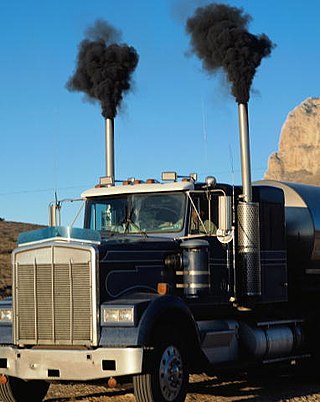
Soot is a mass of impure carbon particles resulting from the incomplete combustion of hydrocarbons. Soot is considered a hazardous substance with carcinogenic properties. Most broadly, the term includes all the particulate matter produced by this process, including black carbon and residual pyrolysed fuel particles such as coal, cenospheres, charred wood, and petroleum coke classified as cokes or char. It can include polycyclic aromatic hydrocarbons and heavy metals like mercury.
In atmospheric chemistry, NOx is shorthand for nitric oxide and nitrogen dioxide, the nitrogen oxides that are most relevant for air pollution. These gases contribute to the formation of smog and acid rain, as well as affecting tropospheric ozone.

Cosmics Leaving Outdoor Droplets (CLOUD) is an experiment being run at CERN by a group of researchers led by Jasper Kirkby to investigate the microphysics between galactic cosmic rays (GCRs) and aerosols under controlled conditions. This is a fixed-target experiment that began operation in November 2009, though it was originally proposed in 2000.
John Hersh Seinfeld is an American chemical engineer and pioneering expert in atmospheric science. His research on air pollution has influenced public policy, and he developed the first mathematical model of air quality, which has influenced air pollution tracking and research across the United States. He has spent his career at the California Institute of Technology, where he is currently the Louis E. Nohl Professor of Chemical Engineering.
A scanning mobility particle sizer (SMPS) is an analytical instrument that measures the size and number concentration of aerosol particles with diameters from 2.5 nm to 1000 nm. They employ a continuous, fast-scanning technique to provide high-resolution measurements.
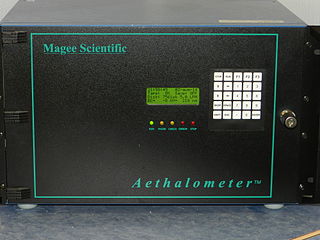
An aethalometer is an instrument for measuring the concentration of optically absorbing (‘black’) suspended particulates in a gas colloid stream; commonly visualized as smoke or haze, often seen in ambient air under polluted conditions. The word aethalometer is derived from the Classical Greek verb aethaloun, meaning "to blacken with soot". The aethalometer, a device used for measuring black carbon in atmospheric aerosols, was initially deployed in 1980 and was first commercialized by Magee Scientific.

Aerosol mass spectrometry is the application of mass spectrometry to the analysis of the composition of aerosol particles. Aerosol particles are defined as solid and liquid particles suspended in a gas (air), with size range of 3 nm to 100 μm in diameter and are produced from natural and anthropogenic sources, through a variety of different processes that include wind-blown suspension and combustion of fossil fuels and biomass. Analysis of these particles is important owing to their major impacts on global climate change, visibility, regional air pollution and human health. Aerosols are very complex in structure, can contain thousands of different chemical compounds within a single particle, and need to be analysed for both size and chemical composition, in real-time or off-line applications.
An aerodynamic aerosol classifier (AAC) is an embodiment of a measurement technique for classifying aerosol particles according to their aerodynamic diameters.
A secondary organic aerosol (SOA) is a molecule produced via oxidation over several generations of a parent organic molecule. In contrast to primary organic aerosols, which are emitted directly from the biosphere, SOAs are either formed via homogeneous nucleation through the successive oxidation of gas-phase organic compounds, or through condensation on pre-existing particles. These gas-phase species exert high vapor pressures, meaning they are volatile and stable in the gas-phase.
Barbara J. Finlayson-Pitts is a Canadian-American atmospheric chemist. She is a professor in the chemistry department at the University of California, Irvine and is the Director of AirUCI Institute. Finlayson-Pitts and James N. Pitts, Jr. are the authors of Chemistry of the Upper and Lower Atmosphere: Theory, Experiments, and Applications (1999). She has been a member of the National Academy of Sciences since 2006 and is the laureate for the 2017 Garvan–Olin Medal. In 2016 she co-chaired the National Academy of Science report "The Future of Atmospheric Chemistry Research"
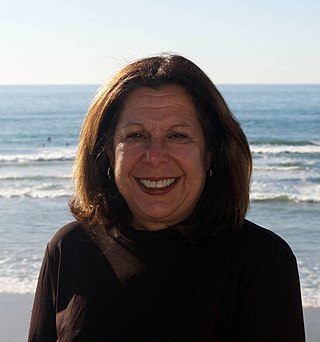
Vicki H. Grassian is a distinguished professor in the department of chemistry and biochemistry at the University of California, San Diego. She also holds the distinguished chair in physical chemistry.
Kimberly A. Prather is an American atmospheric chemist. She is a distinguished chair in atmospheric chemistry and a distinguished professor at the Scripps Institution of Oceanography and department of chemistry and biochemistry at UC San Diego. Her work focuses on how humans are influencing the atmosphere and climate. In 2019, she was elected a member of the National Academy of Engineering for technologies that transformed understanding of aerosols and their impacts on air quality, climate, and human health. In 2020, she was elected as a member of the National Academy of Sciences. She is also an elected Fellow of the American Philosophical Society, American Geophysical Union, the American Association for the Advancement of Science, American Philosophical Society, and the American Academy of Arts and Sciences.
Lynn Russell is a professor of atmospheric chemistry at the Scripps Institute of Oceanography a division of the University of California, San Diego in La Jolla, California.
Barbara Jo Turpin is an American chemist who is a Professor of Atmospheric Chemistry at the University of North Carolina at Chapel Hill. Her research considers aerosol science and environmental engineering. Turpin studies the formation of organic particulate matter via aqueous chemistry. She was awarded the 2018 American Chemical Society Award for Creative Advances in Environmental Science and Technology. Turpin is a Fellow of the American Association for Aerosol Research, American Geophysical Union and American Association for the Advancement of Science.
José Luis Jiménez-Palacios is a Spanish–American chemist and engineer. As a professor of chemistry at the University of Colorado Boulder, Jimenez contributed to the establishment of the Aerodyne Aerosol Mass Spectrometer, an instrument for real-time analysis of aerosol size and composition.
Colin Dermot O'Dowd is an Irish physicist and atmospheric scientist.
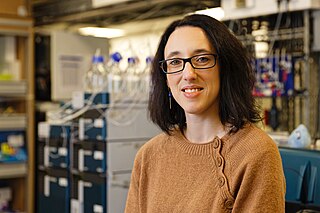
Chiara Giorio is an Italian atmospheric chemist who is an Assistant Professor in the Yusuf Hamied Department of Chemistry at the University of Cambridge, a Fellow of Christ's College and a Fellow of the Community for Analytical Measurement Science.
Nga Lee Ng is the Love Family Professor at the Georgia Institute of Technology, holding appointments in both the School of Chemical and Biomolecular Engineering and the School of Earth and Atmospheric Sciences. Her research focuses on atmospheric chemistry, particularly in the study of organic aerosols and their effects on air quality, climate, and human health.
References
- 1 2 3 4 5 "Richard C. Flagan | Irma and Ross McCollum-William H. Corcoran Professor of Chemical Engineering and Environmental Science and Engineering". www.cce.caltech.edu. Retrieved July 23, 2024.
- ↑ Wang, Shih Chen; Flagan, Richard C. (1990). "Scanning Electrical Mobility Spectrometer". Aerosol Science and Technology. 13 (2): 230–240. Bibcode:1990AerST..13..230W. doi:10.1080/02786829008959441. ISSN 0278-6826.
- ↑ Stolzenburg, Mark R.; McMurry, Peter H. (June 3, 2018). "Method to assess performance of scanning mobility particle sizer (SMPS) instruments and software". Aerosol Science and Technology. 52 (6): 609–613. Bibcode:2018AerST..52..609S. doi:10.1080/02786826.2018.1455962. ISSN 0278-6826.
- 1 2 3 4 5 "Richard C. Flagan". ccst.us. California Council on Science and Technology . Retrieved July 23, 2024.
- 1 2 Flagan, Richard Charles (1973). The formation of nitric oxide from organic nitrogen contained in fossil fuels (Thesis). Massachusetts Institute of Technology. OCLC 24418693.
- 1 2 3 "Richard Flagan" (Interview). Interviewed by David Zierler. Caltech Heritage Project. 2022.
- ↑ "Richard Flagan - Google Scholar Profile". Google Scholar . Retrieved July 24, 2024.
- ↑ "Inventor:Richard Flagan". Google Patents . Retrieved July 29, 2024.
- ↑ "Past Presidents". www.aaar.org. American Association for Aerosol Research. Retrieved July 24, 2024.
- ↑ "About this journal | Editorial Board | Editors-in-Chief Emeritus". Aerosol Science and Technology. Taylor & Francis Online. Retrieved July 24, 2024.
- 1 2 "Professor Richard C. Flagan". National Academy of Engineering . Retrieved July 23, 2024.
- ↑ Tortorello, Michael (February 9, 2011). "Speck by Speck, Dust Piles Up". The New York Times .
- ↑ Tobin, Emma H. (January 28, 2022). "How many times can I reuse my N95 mask?". Associated Press.
- ↑ "Winners: Shell Thomas Baron Award in Fluid-Particle Systems". www.aiche.org. American Institute of Chemical Engineers . Retrieved July 23, 2024.
- ↑ "Fuchs Memorial Award". www.aaar.org. American Association for Aerosol Research. Retrieved July 23, 2024.
- ↑ "ACS Award for Creative Advances in Environmental Science and Technology Recipients". www.acs.org. American Chemical Society . Retrieved July 23, 2024.